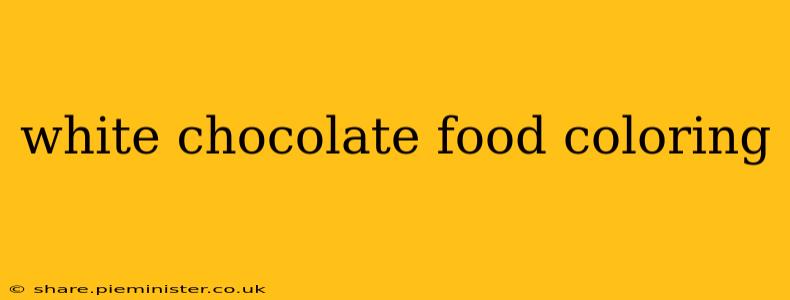White chocolate, with its creamy sweetness, is a beloved ingredient in countless desserts. But sometimes, the pure white canvas needs a little… color. Whether you're creating a vibrant holiday treat or a sophisticated dessert masterpiece, achieving the perfect shade in white chocolate can be tricky. This guide explores the best methods and considerations for coloring white chocolate, addressing common questions and concerns along the way.
What Kind of Food Coloring Works Best with White Chocolate?
This is a crucial question! Not all food colorings are created equal, and some react poorly with white chocolate, leading to discoloration, graining, or an unpleasant texture. Generally, oil-based gel food coloring is the best option. These gels are highly concentrated, requiring less to achieve vibrant colors, and their oil base is more compatible with the fat content of white chocolate. Avoid water-based liquid food colorings; they can cause the white chocolate to seize and become grainy.
Can I Use Powdered Food Coloring with White Chocolate?
While powdered food coloring can be used, it's generally not recommended. Powdered colorings can be difficult to incorporate fully into white chocolate, potentially leading to uneven color distribution and a gritty texture. The effort required often outweighs the results, especially when superior alternatives like gel colorings exist.
How Do I Add Food Coloring to White Chocolate Without Ruining It?
The key to successfully coloring white chocolate is a gentle and gradual approach. Here's a step-by-step process:
-
Melt the white chocolate: Use a double boiler or microwave in short bursts, stirring frequently to prevent scorching. Ensure the chocolate is completely smooth and melted before adding any color.
-
Temper the white chocolate (optional but recommended): Tempering ensures a smooth, shiny, and less prone to blooming finish. There are several methods for tempering; researching the best method for your needs is recommended.
-
Add the gel food coloring sparingly: Start with a tiny amount of gel color and mix thoroughly. Add more color gradually until you achieve your desired shade. It’s easier to add more color than to take it away.
-
Mix thoroughly: Use a spatula or spoon to ensure the color is completely incorporated and evenly distributed throughout the chocolate.
-
Test the color: Before using the colored chocolate, test a small amount on parchment paper to ensure you've achieved your desired hue.
Does the Type of White Chocolate Matter?
Yes, the type of white chocolate can influence the final color and texture. Higher-quality white chocolate, with a higher cocoa butter content, tends to be more stable and less prone to seizing. Consider using a good quality white chocolate for optimal results.
How Do I Prevent My White Chocolate From Seizing?
Seizing occurs when the fat in the white chocolate separates, creating a grainy, unattractive texture. The most common cause is introducing water into the melted chocolate. Using oil-based gel food coloring, working with completely dry utensils, and avoiding adding water to the melted chocolate are key to preventing seizing.
What Are Some Creative Ways to Use Colored White Chocolate?
Colored white chocolate opens a world of creative possibilities! Consider these ideas:
- Drizzles: Create beautiful drizzles over cakes, cupcakes, or cookies.
- Dipping: Dip strawberries, pretzels, or cookies for an elegant touch.
- Candy melts: Make colorful shapes and candies.
- Ganache: Make a colored ganache for cake fillings or frostings.
- Decorations: Use it to create intricate decorations for cakes and other desserts.
By following these tips and techniques, you can confidently add a splash of color to your white chocolate creations, resulting in stunning and delicious treats. Remember to always prioritize quality ingredients and a gentle touch to achieve the best possible results.
